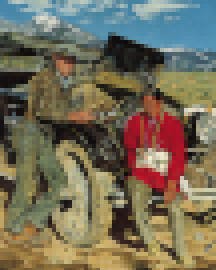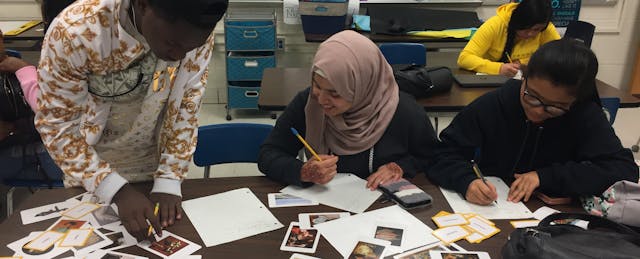Moving to a new home and starting a new school would be intimidating—even terrifying—for most teenagers. But for Lian and Lisbet, who moved to a home they did not choose in a place they did not know and needed to communicate in a language they did not speak, these transitions have led to freedom for them and their families.
Lian, from Myanmar, is a senior who is looking forward to graduating and joining her sister Muan at community college. Lian had learned to read and write in English while living in Malaysia, where her family waited for two years to immigrate to the U.S., but she could not speak it when she finally arrived here. Now, nearly three years later, she raises her hand, and her voice, in class. Her determination to speak English, and her hard work in the classroom, has propelled her to membership in the National Honor Society and consideration for several scholarships.
Lisbet moved to the United States from Santiago, Cuba—a place she says rumbles with earthquakes daily—stopping first in Miami and then on to Louisville, Ky., and into my classroom. Lisbet is constantly working to improve her English, collecting colloquialisms and slang and practicing their use. She has strong, thoughtful opinions, and often writes her ideas first, before sharing them in class. This year, she was one of eight students selected for the school’s Aspen Challenge Team, a prestigious problem-solving competition sponsored by the Aspen Institute.
As focused as both young women are on integrating into their new home, they are both fiercely protective of maintaining their first languages, their cultures and their identities. Lian and Lisbet are not alone. They are classmates in the second cohort of the Accelerate to Graduate, or A2G, program at Iroquois High School, where I teach. A2G is a yearlong high school acceleration program designed for immigrant students. Each has a story to tell. Fortunately for them and their new community, they are now being given a chance to tell them thanks to a new collaboration with the Speed Art Museum, the oldest and largest art museum in Kentucky.
For the project, which was designed by museum staff, students are lending their voices to record the reflections of immigrant teens about works of art currently on display. This dynamic partnership combines art, community and a sense of welcomeness, helping our students protect their identities and connect past experiences to their current lives in the U.S. The project is being completed in conjunction with a traveling exhibition opening in the Spring of 2019, called “The American Library,” celebrating the vast diversity of American citizens, by the artist Yinka Shonibare.
Students first selected a work of art from the permanent collections of the museum that evoked an emotion or particular connection associated with their move to America and away from their home countries, and wrote about it.
Some shared their tears. “I was crying because I knew that I will miss my family, my friends, everybody,” one student wrote. Others characterized hardships along the journey.
“When we walked for one day, our legs were hurt because of the rocks,” wrote Lian, who chose a painting titled “Bob Abbott and His Assistant” by American artist Walter Ufer showing two men beside an old black car, hood popped open. She picked it because, “The car looks like the one my family was in, in Myanmar and it broke and we couldn’t continue going.”
Later, students recorded their stories in their first or other language of their choice (some students speak up to five). By writing and storytelling in their own languages, students are bringing heartfelt authenticity to their journeys, free of the barriers of speaking in a new and unfamiliar language. Yet several students, including Lian are choosing to speak in English on their recordings. As one student said, and others echoed, English is the way to share these stories with the people who need to hear them.

In their stories, students referenced struggles with maintaining their identities while integrating into their schools, their neighborhoods, their city and American culture in general. As Lisbet said, “We want to be like the Americans we see, and sometimes people lose themselves when they try to be like people in their new culture.” Yet Lisbet also talks about how her dreams came true when her move to the U.S. reunited her with her mother.
Lian used part of her story to talk about the aromas she encountered in her new home, and decides that the unfamiliar smells of fast food, hospitals and air conditioning, “smells like more than just freedom.”
Just like here in the U.S., museums are familiar to some students, and foreign to many others. A student from Honduras reported that art was an integral part of her coursework in her home country, as were visits to museums and cultural sites. Others, from Syria and Vietnam, had no formal exposure to art or museums before their visits to the Speed.
The museum staff invited students, sans tour guides, to explore the collections on their own to find the piece to critique. Hesitant at first, students quickly took the reigns and roamed the galleries searching for the piece that spoke to them. Perhaps for that reason, students have embraced this project and believe the museum staff when they say they want to hear real stories of connection.
One student speculated that their museum has so many things from so many cultures, they need people from around the world to help them learn about the art. Another student answered very honestly that she did not know why they would want her opinion on art. But she shared hers anyway.
Each year students complete a “sustained inquiry” project, which they work on throughout the year. The current topic is immigration. Students began with the question, “Why do some U.S. citizens fear immigrants?” Sadly, this was not an unfamiliar concept to many of them. Students with all levels of English proficiency have participated in these discussions, nodding in recognition when their peers have recounted ill-treatment from other Americans.
To me, it illustrates why this project is so critical for supporting these students’ sense of their value and for giving importance to their voices. When they read the words of Warsan Shire, a poet from Kenya, that, “...you have to understand, that no one puts their children in a boat unless the water is safer than the land…,” these are words they read knowingly, sympathetically and as a reality most of them share with so many others.
Lian and Lisbet are designing new lives that they hope will carry their past into their futures. Both young women are hopeful that they will become naturalized citizens one day. They aspire to become college students and graduates. They want to work and have the resources to take care of themselves and their families. They know they will always be immigrants. And happily, the invitation to collaborate with the staff at the Speed is offering Lian, Lisbet and their peers the opportunity to share and celebrate who they are, and where they came from, while finding out where life will take them, letting them know that they will always be welcomed.


